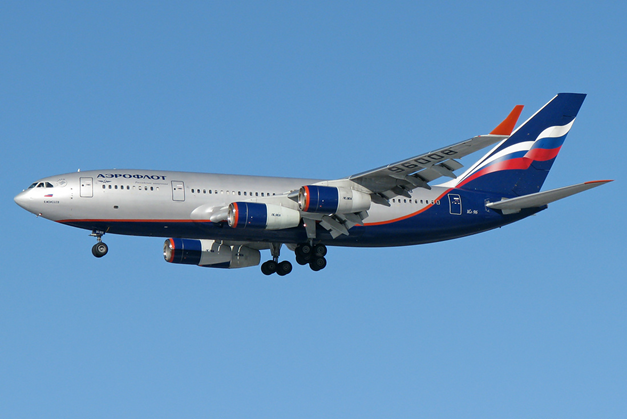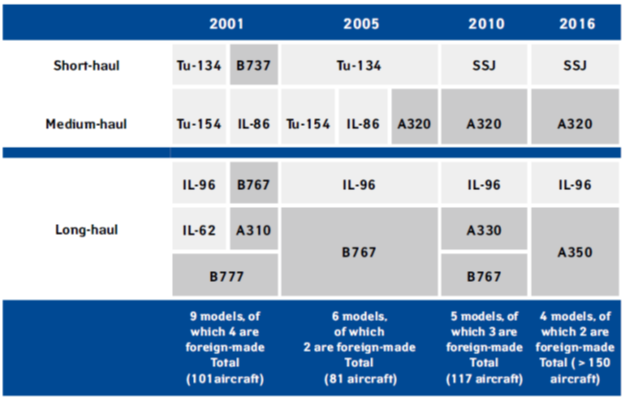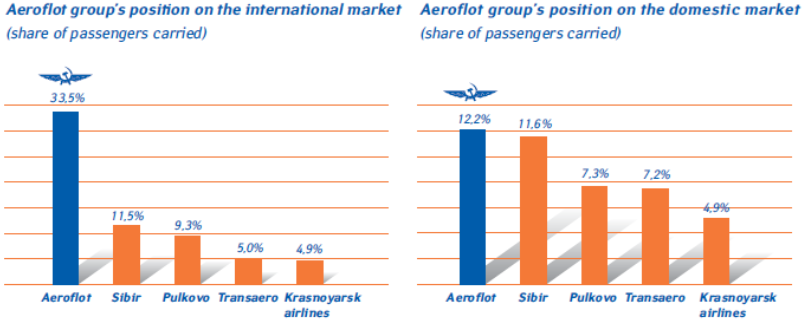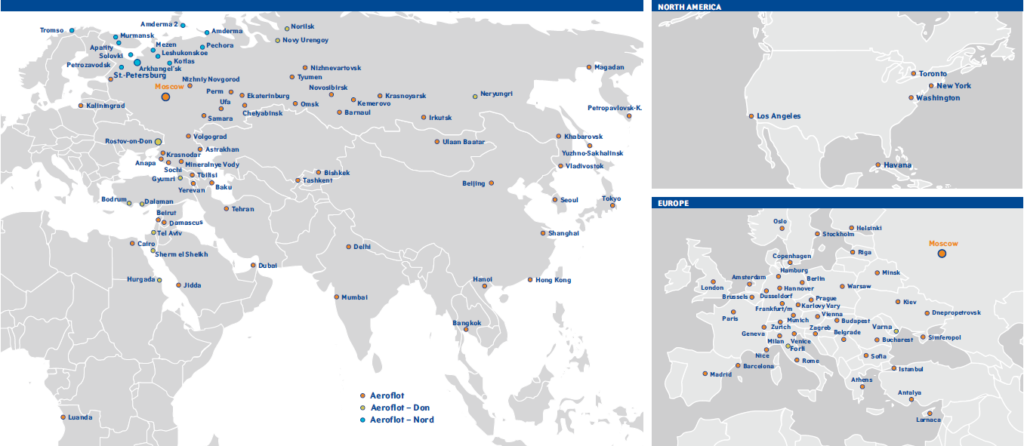Leeham News and Analysis
There's more to real news than a news release.
Aeroflot, the route to a modern airline, Part 2
By Bjorn Fehrm
April 19, 2017, ©. Leeham Co: In our second article about Aeroflot, the Soviet Union flag carrier that transformed to a modern airline, we will cover the period from the fall of the Soviet Union until 2010.
This was the difficult period for all participants. The old structures no longer existed and were replaced with… nothing, followed by uncertainty and a long struggle to get back to normal.

Figure 1. IL-96-300, a Soviet long range aircraft which stayed in the Aeroflot fleet until 2014. Source: Aeroflot.
The period after the Soviet Union
As we finished last week, Aeroflot had around 200,000 employees operating 2,000 aircraft at the end of the Soviet era. The transformation from a state-controlled Soviet Union to independent states took from early 1990 to end 1991. In December 1991, the Commonwealth of Independent States (CIS) was formed with nine out of the 15 former Soviet Republics as members. Russia transformed into the Russian federation, geographically the largest country in the world with 145m inhabitants living in 22 republics.
The states that left the Soviet Union formed their own airlines out of the Aeroflot organizations in the areas. Aeroflot’s central part stayed with Russia, but the Russian domestic traffic was to a large part operated by 30 spun off “Babyflots,” formed from Aeroflot’s republic directorates.
Outside Russia, there were around 300 airlines set up by the former Soviet states. The majority did not have the critical mass to operate as airlines. Operations suffered as a result, as did safety. Passengers had to wait forever on delayed flights in badly maintained airport facilities. When the aircraft finally took off, it was often overloaded and had remaining deficiencies.
Accidents were the consequence, caused by lapsed maintenance, bad operational practices and simple lack of means to operate. In the mid-1990s, the US Embassy recommended travelers flying in the former Soviet Union take the train instead. Flying was too risky.
Gradually, the authorities increased the controls and shut down airlines that could not meet operational standards. At the turn of the century, most of the non-viable airlines had been liquidated or merged into viable operations.
During this time, Aeroflot, which by 1995 was 51% owned by the Russian state with the remaining 49% sold to employees, kept standards. There were no accidents except for one instance where a Captain let his 15-year old son fly. It did not end well. A new Airbus A310 (acquired in 1992 as first foreign aircraft type) with passengers perished.
The focus for Aeroflot, now named “Aeroflot – Russian International Airlines,” was international traffic to and from Russia. Domestic traffic was not a priority and market share was below 10%. At the end of the 1990s, Aeroflot refocused the domestic market and changed its name from “Aeroflot – Russian International Airlines” to “Aeroflot-Russian Airlines”. It reflected the changed focus.
The domestic market was by then in the hands of major competitors to Aeroflot. The largest domestic airline was Siberian Airlines (today, S7 Airlines). Domestic flights were a quarter of Aeroflot’s operation. With the refocus, Aeroflot gradually worked its way to a domestic leader.
Figure 3 shows the market shares for international and domestic traffic by 2003.
Profits since 2000
The turn of the century also meant a turn in the business performance. Aeroflot has been profitable since 2000, with a gradual increase in Shareholders equity (Shareholder value gain) over the years, Figure 4.
The airline was now working hard to improve operations. Aeroflot started the transformation to an airline of Western standards. It successively met the operational and safety standards of Western authorities, such as the US FAA and IOSA (IATA’s Operational Safety Audit) .
Modern systems and procedures were introduced. SAP R3 (the world’s most recognized resource management system) was introduced for resource management and economical follow up/reporting. Sabre was chosen as the group’s new route network pricing and management system.
Soviet aircraft, which were safe but inefficient, were gradually replaced with modern Western types. By 2000, the airline’s fleet contained a mix of Soviet and Western types, Figure 5.
Joining a global alliance
Aeroflot was actively working to enter one of the Global alliances, to increase the connecting traffic to and from alliance partners. It took six years to be accepted in Sky Team (with Delta and Air France/KLM as leading airlines).
There were many requirements to be part of a Global alliance. One was customer satisfaction at 85% or better. Aeroflot set about changing passenger perception. Market and customer research showed that in-flight service (appearance, food, entertainment) needed improvement. A major change program was started. Branding, uniforms, personnel attitudes and in-flight services were improved.
By 2006 Aeroflot was accepted in the Sky Team alliance (figure 6). Investments in customer service and marketing had paid off. Aeroflot’s brand and customer satisfaction research showed increased rankings year by year.

Figure 6. SkyTeam members 2006 when Aeroflot joined. Continental Airlines later merged with United and joined Star Alliance. Source: Aeroflot.
By 2006 the international route network was flying to 90 destinations in 47 countries, Figure 6. The domestic market share was now 17%.
Modern fleet
In 2008, Aeroflot set the long-term development of its fleet by signing an agreement with Airbus for 22 A350s and 10 A330s. Figure 7 shows the long-term fleet plan as presented 2007, after the Airbus agreement.

Figure 7. Aeroflot fleet plan after the Airbus agreement to order 22 A350 and 10 A330. Source: Aeroflot.
The IL-96-300 (figure 1) should remain in the fleet beyond 2016 according to the plans from 2007. The Il-96-300 is a rather up to date Soviet aircraft, a bit of an A340-200 in terms of capacity and performance (the A340-200 was shorter than the A340-300, with a fuselage and cabin the length of the A330-200). In the end Aeroflot ordered more A330-200s, which had the capacity, range and about 10% higher efficiency than the Il-96-300. The Il-96-300 exited the Aeroflot fleet 2014.
Development after 2008
The consolidation of the Russian domestic airline market started after 2000. Gradually, it picked up speed. Aeroflot bought Donavia and named it Aeroflot-Don and later formed Aeroflot-Nord by acquiring Arkhangelsk Airlines. The Russian government in 2010 merged the airlines in its ownership into Aeroflot. Vladivostok Avia, Saravia, SAT Airlines, Orenair and Rossiya Airlines were merged into the Aeroflot group.
Competitor Siberian Airlines took over Vnukovo Airlines, Baikal Airlines, Chelyabinsk Airlines and Enkor.
With these changes the modern Aeroflot was established. We will cover its development in the next article.






Bjorn
Thank you for another excellent article!
Back when Aeroflop flew 96s into Seattle, I often transported Russian crews to their RON hotel. Next day, the outbound Moscow crew would fill three luggage-bays with COSTCO purchases for family, friends, and resale: Sets of tires, Weber grills, almost ANY treasure not easily/cheaply available in Moscow.
My favorite FA was Marina [said her husband was a musician/conductor]. One day, boarding my shuttle, Marina looking beaten-up as if she had just been ‘interviewed’ by KGB. She claimed while working a 96 galley, the floor collapsed and she fell partially into… [the Captain intervened at once ending our contact].
I never saw Marina again. Nobody would speak about her….Although I once thought I caught a glimpse of her riding a Moscow tram. I ran and ran to catch-up with her….
Dr. Norm